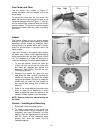
23
7. Support the workpiece while bringing the
tailstock into position about 1” away from
the end of the workpiece. Lock the tailstock
to the bed.
8. Advance the tailstock spindle with the
handwheel in order to seat the live center
into the workpiece. Use enough pressure to
secure the workpiece between the centers
so that it won’t fly off, but do not use
excessive pressure.
9. Tighten the spindle locking handle.
The tailstock ram is capable
of exerting excessive pressure against the
workpiece and the headstock. Apply only
sufficient force with the tailstock to hold the
workpiece securely in place. Excessive
pressure can overheat center bearings and
damage both workpiece and Lathe.
10. Move tool support into position. It should be
parallel to the workpiece, just below the
centerline and approximately 1/8" to 1/4"
from the corners of the workpiece to be
turned, as in Figure 32. Tighten support
base to Lathe bed.
11. Rotate workpiece by hand to check for
proper clearance.
12. Start lathe at lowest speed and bring it up to
the appropriate RPM for the size of
workpiece used. Consult digital readout on
the headstock.
Cutting Techniques
Roughing Out
1. Begin with a large roughing gouge. Place
the tool on the tool support with the heel of
the tool on the surface to be cut.
2. Slowly and gently raise tool handle until
cutting edge comes into contact with the
workpiece.
3. Beginning about 2” from the tailstock end of
the workpiece, roll the flute (hollowed-out
portion) of the tool in the direction of the cut.
See Figure 33. Make long sweeping cuts in
a continuous motion to rough the piece
down to a cylinder.
4. Keep as much of the bevel of the tool as
possible in contact with the workpiece to
ensure control and avoid catches. NOTE:
Always cut down-hill, or from large diameter
to small diameter. Always work toward the
end of a work-piece, never start cutting at
the end.
Figure 32
Figure 33


















